We all know that a penny is the smallest value coin in the US. Thus, it is typical to perceive it as a less valuable piece. But what about those without a mintmark, like the 1965 penny? Are they worth any money compared to those within the series?
In this article, we will answer all your questions and explain why it arrived at such a valuation today. But to kick it off, here’s a summarized estimated value of each based on their color. Then, later, we will comprehensively discuss each of their grades.
| 1965 Penny Value Chart Based On Coin Color | |||
| Mint Location | Coin Series | Color | Estimated Value |
|
Philadelphia, Denver, and San Francisco |
1965 Regular Strike Penny |
BN | $0.05-$7.50 |
| RB | $2.50-$20 | ||
| RD | $5-$175 | ||
|
San Francisco |
1965 Special Mint Set Penny |
BN | $0.05-$22 |
| RB | $4-$36 | ||
| RD | $9-$1,000 | ||
| RD CAM | $125-$1,600 | ||
The Striking History of The 1965 Lincoln Cent
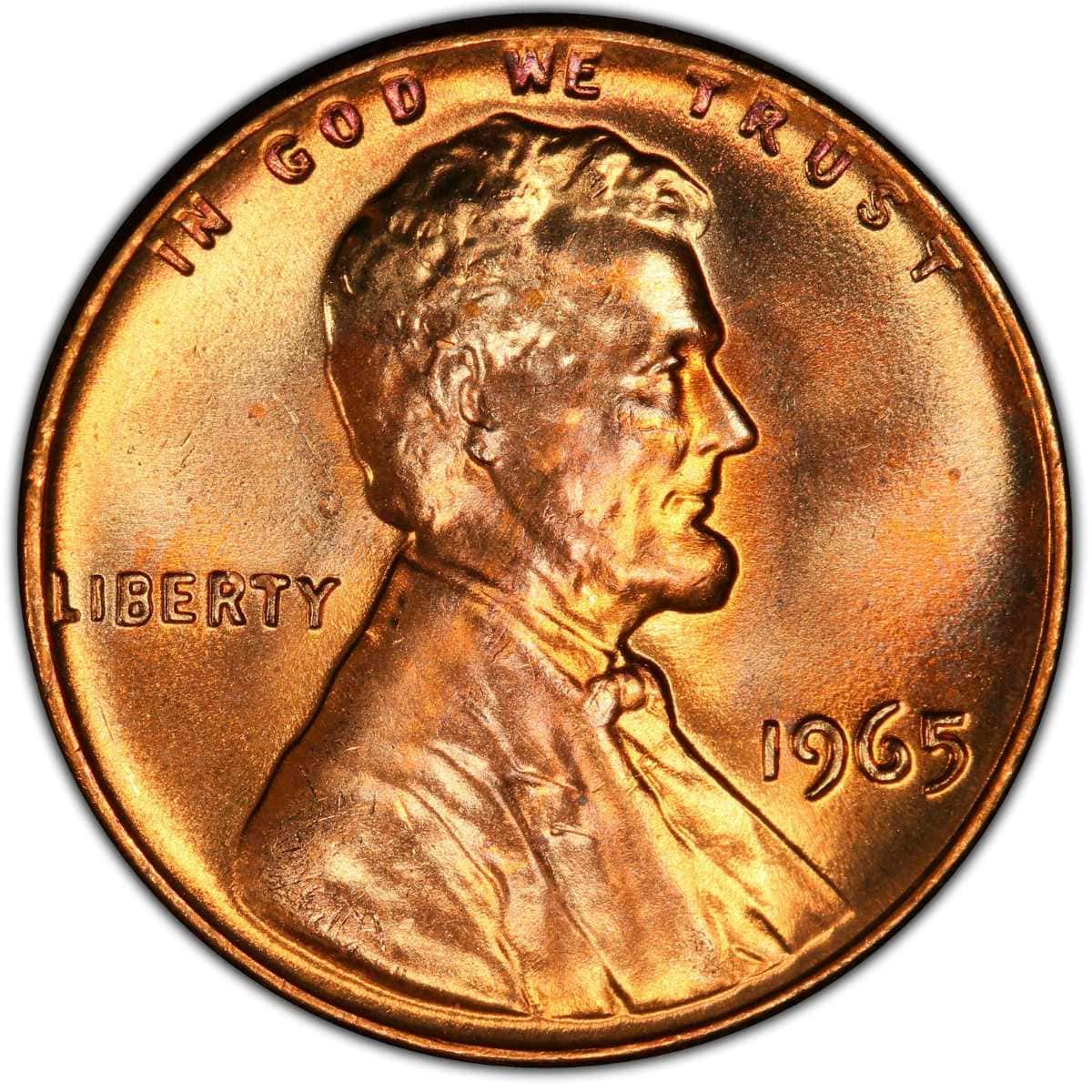
The Lincoln Cent or Penny has long been in the history of the U.S. currency. Its modifications throughout the century revealed its age, from many reverse faces that marked the one-cent to the various metal compositions that graced the hands of the general public.
But before the current Shield Lincoln Cent we know today, the Memorial Reverse rolled first from 1959 to 1982 for the Modern Type pennies. However, this lengthy series was not all rainbows and butterflies for the U.S. Mints as coin shortages emerged midway through coin production.
In 1965, the Mint facilities discontinued the release of proof coins to focus on regular-issue coinage, and Congress prohibited adding mintmarks.
With this, it is impossible to pinpoint the exact origin of billions of 1965-dated pennies that made it into circulation. However, one thing is indubitably: Philadelphia, Denver, and San Francisco all worked to alleviate the existing coin scarcity.
Aside from the business strike coins, it was also in 1965 when the San Francisco Assay Office was permitted the release of Special Mint Sets (SMS). It is their way to fill the gap after not releasing 1965-proof coins. Proof coins only returned in 1968 after the U.S. Mints overcame the production disturbance.
1965 Penny Specification and Design Details
- Category: Memorial Reverse Lincoln Cents (1959-2008)
- Face Value: One Cent
- Obverse Designer: Victor D. Brenner
- Reverse Designer: Frank Gasparro
- Metal Composition: 95% Copper, 5% Zinc
- Weight: 3.11 grams
- Diameter: 19.00 millimeters
- Edge: Plain
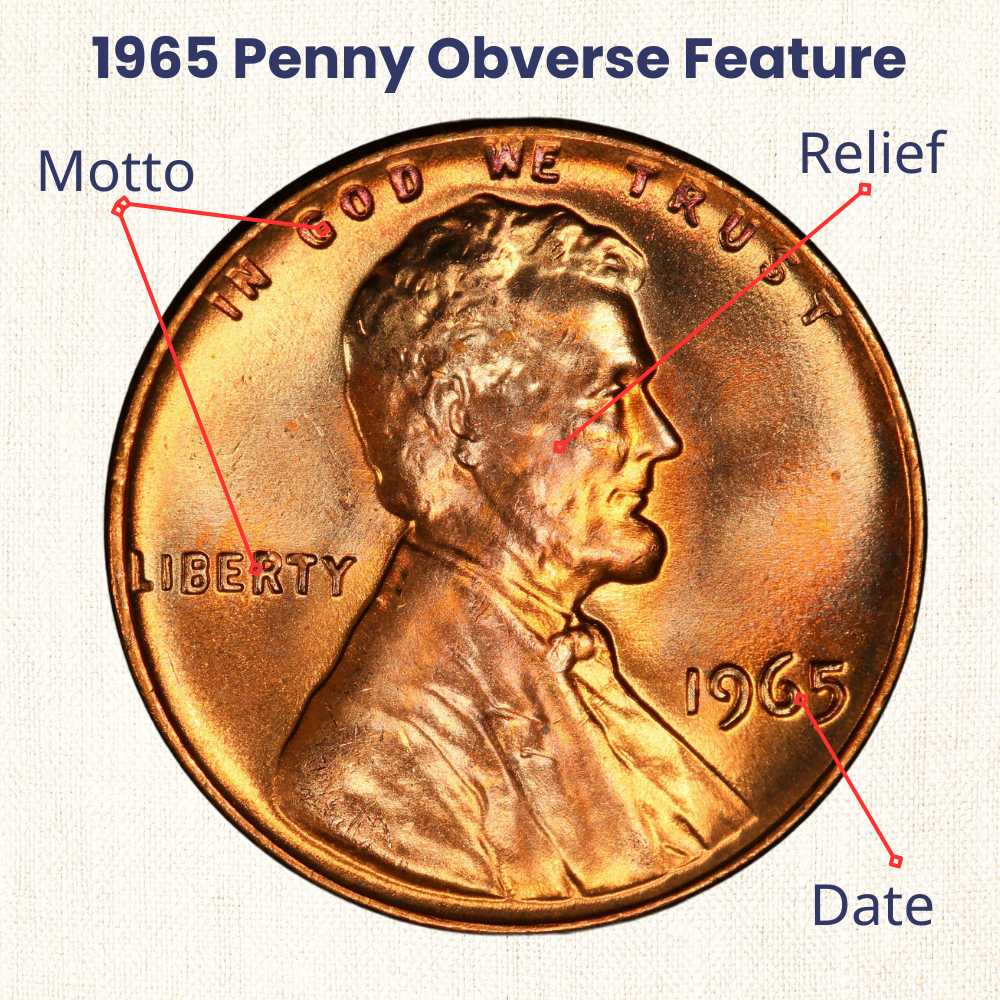
The obverse design of the Lincoln Cent features the original design of Victor Brenner. On the center is the bust of President Lincoln, facing towards the right. Surrounding it are the words IN GOD WE TRUST, LIBERTY, and the mint year. Formerly, you’ll also find the mintmark below the date. However, none can be seen due to the Coinage Act of 1965.
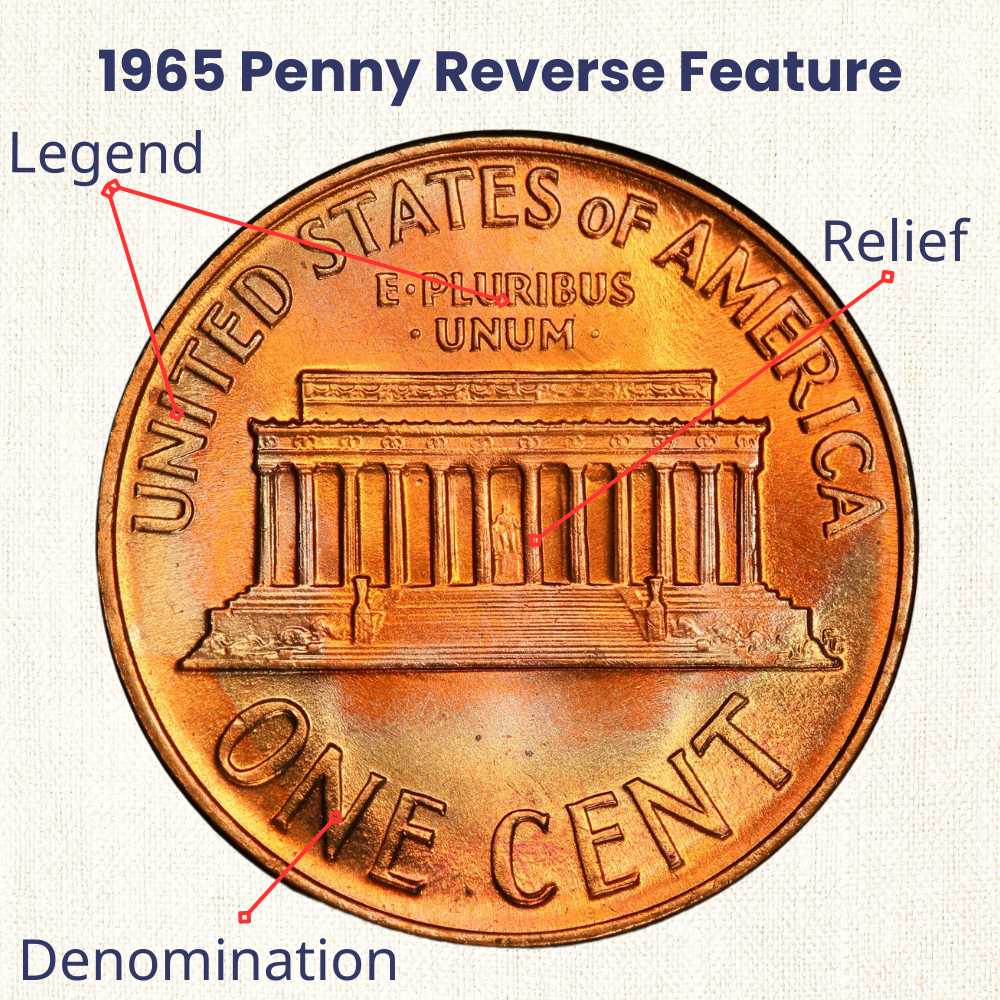
On the reverse side, the Lincoln Memorial replaced the original wheat design. Frank Gasparro’s modification commemorates the sesquicentennial of the president’s birth year. Bordering it are the words UNITED STATES OF AMERICA, E PLURIBUS UNUM, and ONE CENT.
1965 Penny: Color Grade and Valuation
The coin market considers many factors that could influence the penny’s price and value. Among those are the survival rate, the demand, and, of course, the grade or condition. But aside from this, the coin color is also a determinant for copper-made coins.
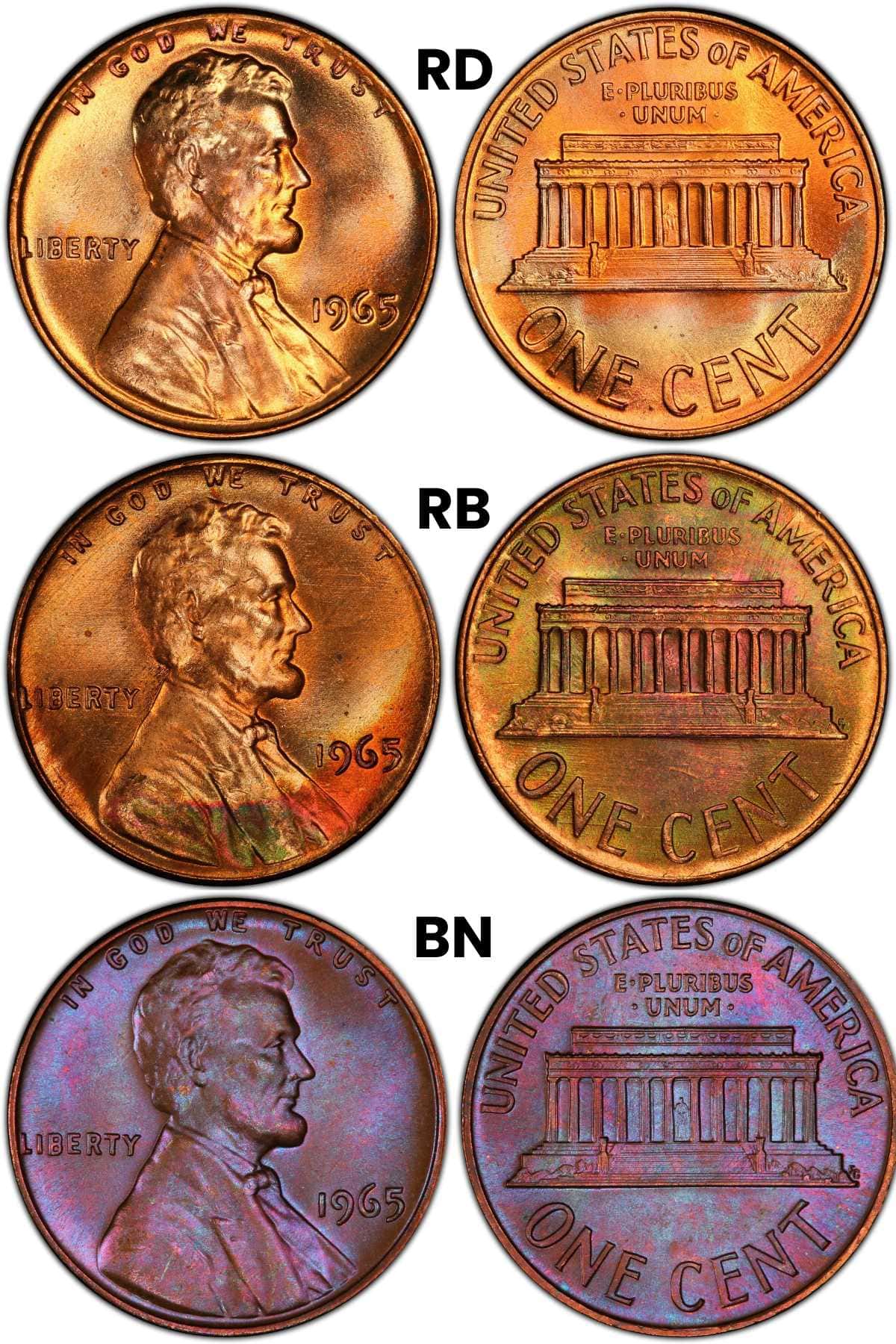
Throughout time, the distinctive red luster of pennies fades into a brown patina. Humidity and moisture are the two common triggers that can cause this. Immediately, you can conclude that those with red (RD) color sell for a higher value compared to red-brown (RB) and brown (BN). But this does not mean that all brown-colored pennies are in circulated condition. Some coins still tone when stored in a reactive holder or album.
So, now that we’ve shone a light on the coin color, we can proceed with the valuation of each variety.
1965 (Regular Strike) Penny Value
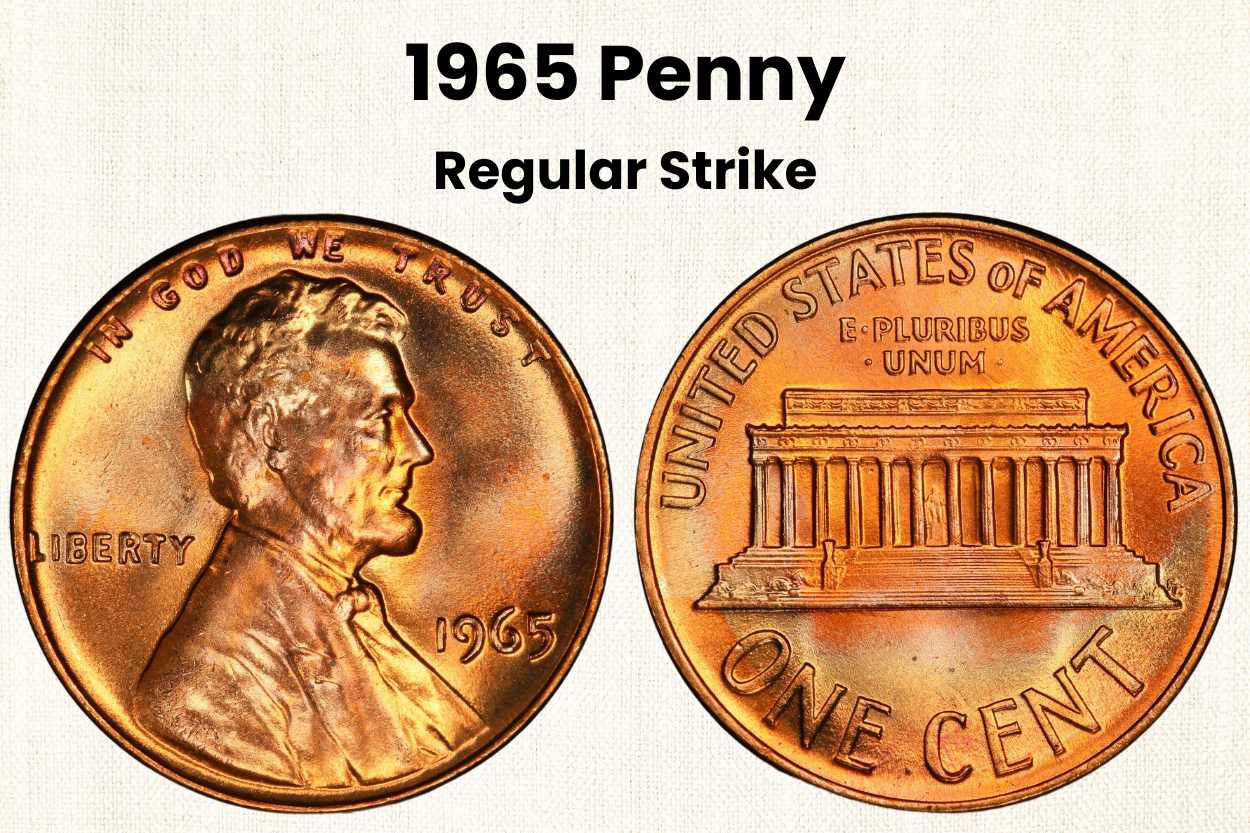
The absence of a mintmark often directs it to the mother Mint, Philadelphia. However, the 1965 to 1967 coins are an exception for the series. Over a billion 1965-dated regular strike pennies rolled out of the three US Mints for circulation, none presented with a D or S mark.
A 1965 penny in circulation condition sells for only $0.05, while About Uncirculated grades can reach $0.10. This is because the materials, copper and zinc, have an intrinsic value less than their face value, making these coins rarely sell for more than a dollar. It is also evident for uncirculated conditions as the BN is valued at $0.10 to $7.50, RB at $2.50 to $20, and RD sat between $5 to $175.
But as we all know, tides can change if a coin appears on an open auction. The highest auction record is from an MS68 RD sold at $3,650.00 on eBay in 2021. The error elevated its value, fetching thousands of dollars. But if we exclude those with Mint error, the highest stands at $2,645 for an MS67 sold by Bowers & Merena in 2008.
While aside from its metal composition that suggests its worth, the population estimate also affects it.
The 1965 Lincoln Cent RD is very common across all grades—except MS66 and above, which are somewhat scarce. Out of the billion minted, over 149 million RD samples survived today and are readily available at coin conventions or online market sites.
On the other hand, RB and BN have less than a thousand samples graded. But not to confuse first-time collectors, as many don’t register pennies due to their low price point. Undoubtedly, many of these coins are still in circulation today and available at affordable prices.
| 1965 Lincoln Cent Value Chart | |||
| Coin Grade | BN | RB | RD |
| Circulated
(G4-XF40) |
$0.05 | / | / |
| About Uncirculated (AU50-AU58) | $0.05-$0.10 | / | / |
| Uncirculated
(MS60-MS64) |
$0.10-$1.50 | $2.50-$5 | $5-$7.50 |
| Gem Uncirculated
(MS65 and above) |
$2.50-$7.50 | $7.50-$20 | $15-$175 |
1965 SMS Penny Valuation
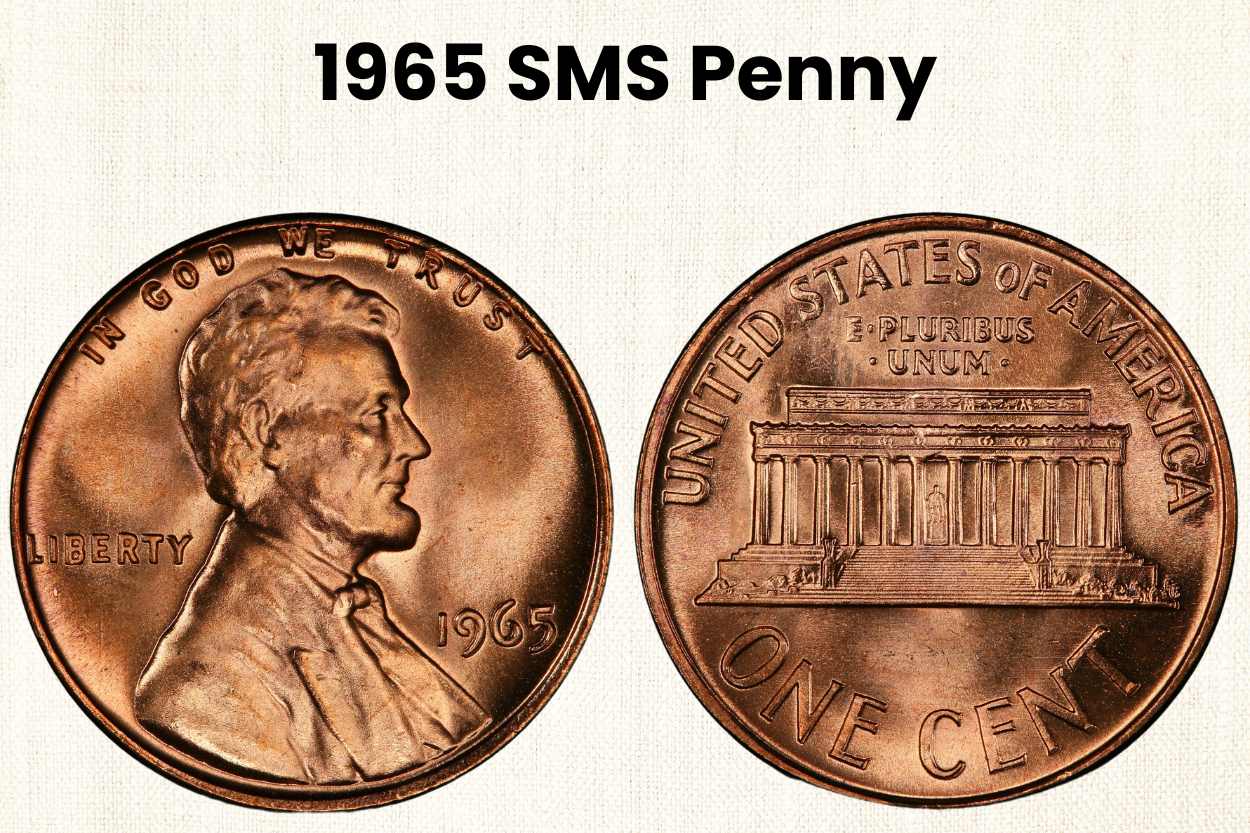
From 1965 to 1967, proof coins ceased as they required more work with the die and blank preparation. The significant demand is not ideal if the US Mint plans to focus on its backlogs on regular strike pennies. So, to recoup, the San Francisco Mint released over 2 million Special Strike coins instead. They are higher in quality than business strike coins but not quite at par with proof coins to earn the designation.
The Special Strike coins are prepared similarly to proof coins, except the planchet did not receive any special treatment before striking. Despite this, you can still expect the higher grades to command a higher price.
Circulated condition 1965 SMS penny remains at $0.05, while About Uncirculated grade is valued lower at $0.07 to $0.08. The demand for low-grade SMS coins is little since it is common in many Internet auction sites. Additionally, if you want to own a Special Strike coin, aiming for a higher grade is worth collecting than settling for circulation grades.
Uncirculated 1965 Lincoln Cent can sell between $0.15 to $1,000, depending on the coin color. Meanwhile, a 1965 RD with a cameo characteristic can fetch from $125 to $1,600. Cameo coins sell for a premium because of the amount of contrast between the relief and field, which is absent on regular strike coins.
With coin condition, the MS68 is the highest grade available for this variety. However, it is an MS67 specimen that holds the sole DCAM designation. The said coin was sold for $4,140 by Heritage Auctions in 2004.
| 1965 SMS Lincoln Cent Value Chart | ||||
| Coin Grade | BN | RB | RD | RD CAM |
| Circulated
(G4-XF40) |
$0.05 | / | / | / |
| About Uncirculated (AU50-AU58) | $0.07-$0.08 | / | / | / |
| Uncirculated
(MS60-MS64) |
$0.15-$1.75 | $4 | $9 | $125 |
| Gem Uncirculated
(MS65 and above) |
$10-$22 | $13-$36 | $20-$1,000 | $400-$1,600 |
List of 1965 Penny Error Coins
There are no known die varieties for this issue. But with a billion mintage, it is impossible for error coins not to exist. So, let’s discuss each, including their market value.
1965 Lincoln Cent Struck On Wrong Planchet
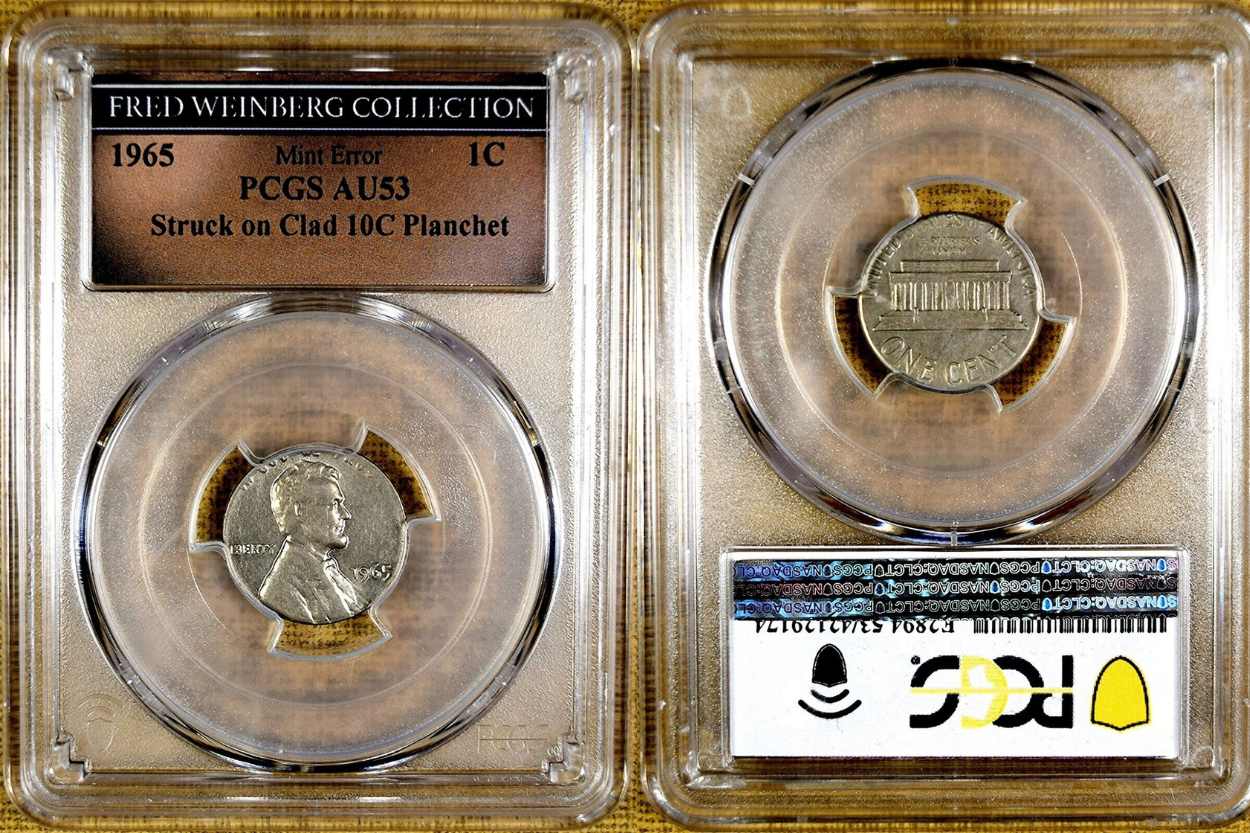
Lincoln Cent struck on a dime planchet are scarce but are obtainable with persistent search. But how does this happen in the first place?
Struck on the wrong planchet may occur when a Mint worker misfed a planchet from one denomination to a coin press with dies from a different denomination. As a result, part of the design is missing since it does not fit the coin size. Usually, the facility notices it before it goes into circulation to destroy it. But if you stumble upon one, expect it to sell from $125 to $350.
1965 Penny Struck Off-Center Error

Off-center coins happen when struck once, although the punch is at the edge. The result is an incomplete coin design with a visible blank space. Now, the question is, what characteristics would make it worth money?
First, collectors prefer dated off-center coins to those with missing digits. Second, 40% to 60% off-center hits the right spot. If the coin presents these characteristics, it can sell for $30 to $1,000.
1965 Doubled Die Penny

A doubled die is a common Mint error in the series. Coins with this error have an additional misaligned impression on the design, either on the obverse or reverse side. However, there are instances when it can’t be seen with an unaided eye, so a coin microscope would help verify it.
This type of error can sell anywhere between $20 to $100. But those in gem condition can fetch $1000+.
1965 Penny Broadstrike Error
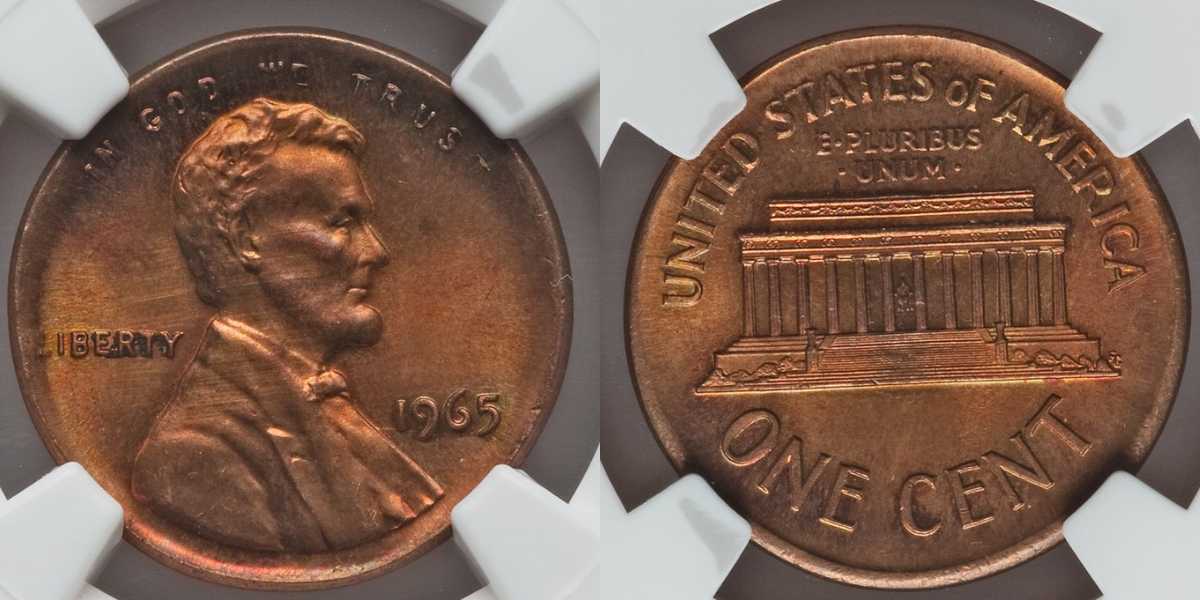
Broadstrike is often mistaken for an off-center strike because of its feature. However, the former presents a complete design, while the latter has incomplete elements. Additionally, broadstrike error is caused by collar die malfunctions, not the punch. As a result, the cent is larger in size than its usual diameter.
Does this raise the value of the coin? It does, but not much like other errors. Coins with broadstrike error can sell for around $5 to $50.
1965 Penny Die Cap Error
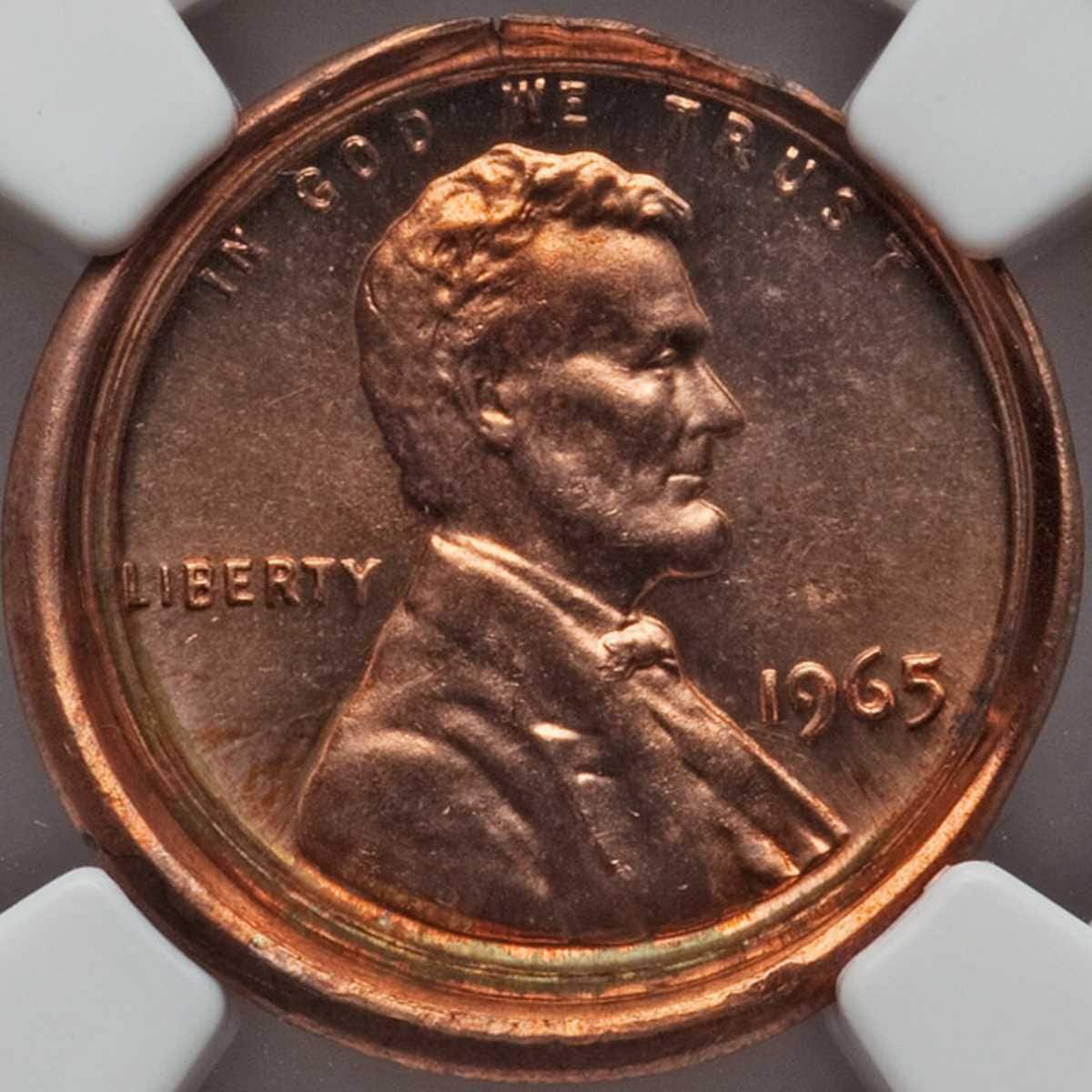
A die cap error resembles a bottle cap, thus the name. This error happens when a coin struck remains on the hammer die, leaving an impression on the succeeding coin. The result is a sunken coin with a slightly bigger diameter than the original one cent.
Coins with a die cap on the obverse side can sell for $150 to $2,500, while an error on the reverse side can fetch $500 to $1,000.
1965 Penny Clipped Planchet Error
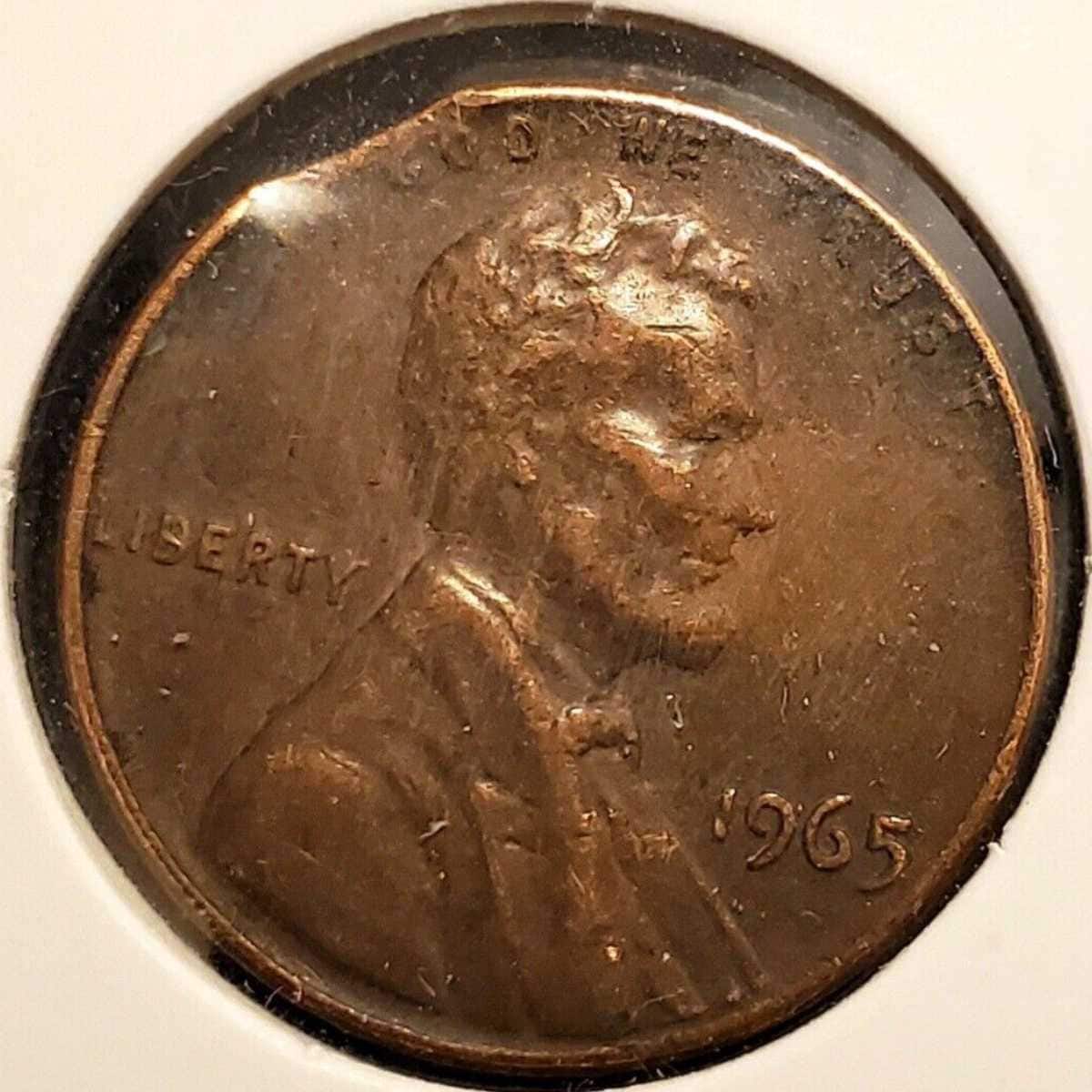
A clipped planchet happens when the blank is punched incorrectly from a metal sheet. When it overlaps the leading edge, it can cause a straight clip, but when the punch strikes an area with a hole left by the previous strike, it results in a curved clip. For curved-clip coins, you’ll also notice a Blakesley effect. It is a distortion that occurs on the opposite side of the clip.
Coins with this error type can sell for about $3 to $8 but can go over for those in higher grades.
Frequently Asked Questions
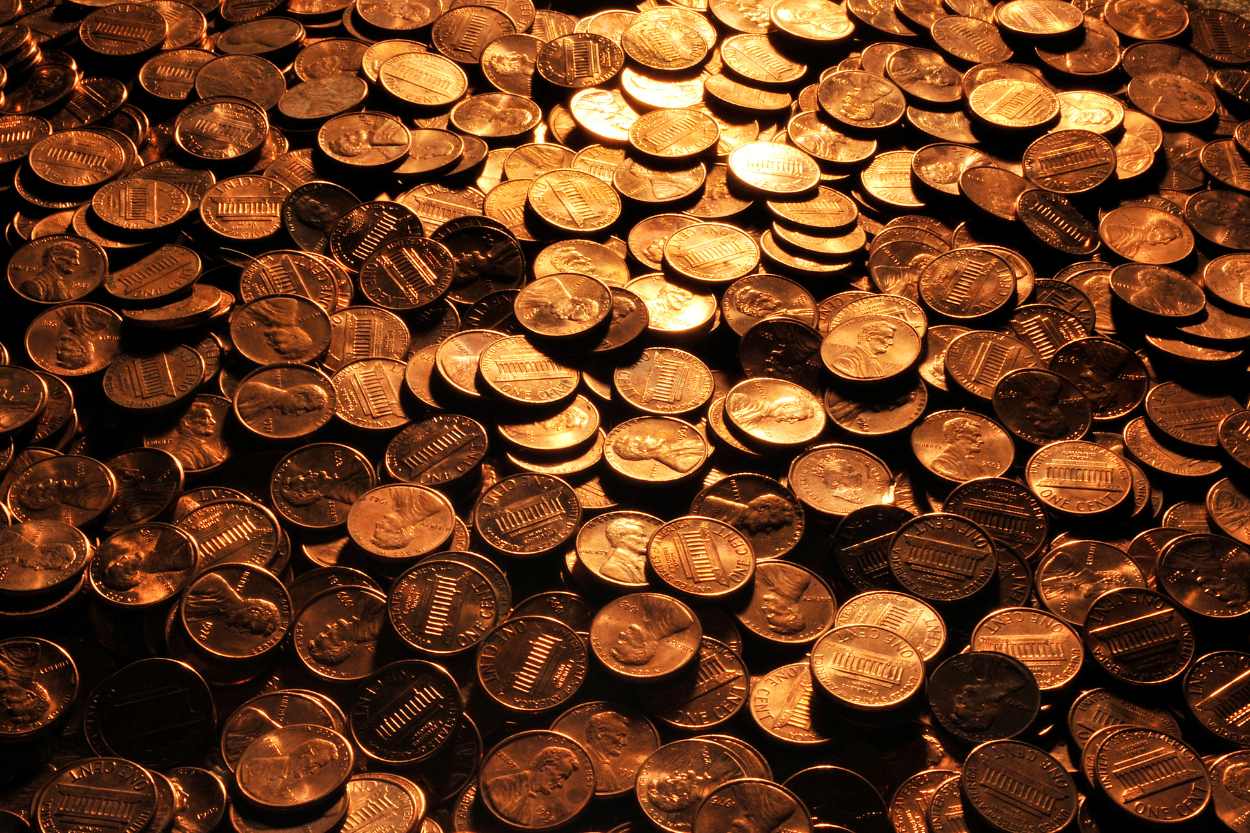
Are 1965 pennies made of copper?
Yes, the 1965 Lincoln Cent is made of 95% Copper and 5% Zinc, weighing 3.11 grams. It only turned to copper-plated zinc in 1982, reducing its weight to 2.5 grams.
You can perform the drop test to verify if your penny is solid copper. If you hear a high-pitched ring sound, it is copper. But if the sound is a flat clunk, it is copper-plated zinc.
What is the rarest Lincoln Penny?
The long Lincoln Cent Series has a couple of rare varieties, but we’ll focus on the top five that sold for more than $150,000 in auctions.
| Coin Variety | Category | Sale Price | Firm |
| 1943-D 1C Bronze MS64 BN | Wheat Reverse
(Type 2, Steel) |
$840,000 | Heritage Auctions |
| 1943-S 1C MS63 BN | Wheat Reverse
(Type 2, Steel) |
$504,000 | Heritage Auctions |
| 1944-S 1C MS66 | Wheat Reverse
(Type 2, Steel) |
$408,000 | Heritage Auctions |
| 1958 1C DDO MS64 RD | Wheat Reverse
(Type 1, Copper) |
$336,000 | Stack’s Bowers |
| 1943 1C AU58 | Wheat Reverse
(Type 2, Steel) |
$218,500 | Heritage Auctions |
| 1909-S VDB 1C MS67 RD | Wheat Reverse
(Type 1, Copper) |
$168,000 | Stack’s Bowers |

Jenson is a professional numismatist, a dedicated coin collector, a graduate of the College of Business at Oregon State, a life member of the American Numismatic Association (ANA), and an overall coin nerd. He is the founder of Coin Value List.
